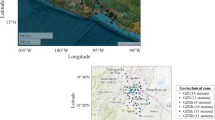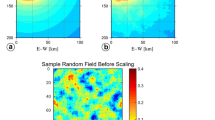Abstract
This study quantitatively investigates the duration effect on structural collapse assessment, using hazard-consistent ground motion suites selected based on the generalized-conditional-intensity-measure approach. Sixteen scenario cases with varying magnitudes, distances, and conditioning periods are considered as targets. For each target case, four hazard-consistent ground motion suites with different distributions of duration (one base-duration (actual target) suite and three longer-duration suites respectively) are selected. Collapse fragility curves are derived by conducting incremental dynamic analysis on numerical models of four steel frames. Comparative results demonstrate that the duration effect on structural collapse capacity mainly depends on the magnitude of the mean significant duration (Ds5–75) ratio of two (longer/base) groups. The duration effect is statistically insignificant for cases where the mean Ds5–75 ratio is smaller than 1.4, while it is more significant for cases with mean Ds5–75 ratios larger than 1.4, with a reduction in median collapse capacity of, on average, about 10% when using the longer-duration suites as compared to the base-duration one. It is also found that a longer duration record suite with more cumulative intensity contained has a higher possibility to cause a reduction of structural collapse capacity.












Similar content being viewed by others
References
Afshari K, Stewart JP (2016) Physically parameterized prediction equations for significant duration in active crustal regions. Earthq Spectra 32(4):2057–2081
Ancheta TD, Darragh RB, Stewart JP, Seyhan E, Silva WJ, Chiou BSJ et al (2014) NGA-West2 database. Earthq Spectra 30(3):989–1005
Arias A (1970) A measure of earthquake intensity. In: Hansen RJ (ed) Seismic design for nuclear power plants. MIT Press, Cambridge, pp 438–483
ASCE (2016) Minimum design loads for buildings and other structures. ASCE/SEI 7-16, Reston
Aschheim M, Black E (1999) Effects of prior earthquake damage on response of simple stiffness-degrading structures. Earthq Spectra 15(1):1–24
Baker JW (2011) Conditional mean spectrum: tool for ground-motion selection. J Struct Eng 137(3):322–331
Baker JW, Jayaram N (2008) Correlation of spectral acceleration values from NGA ground motion models. Earthq Spectra 24(1):299–317
Barbosa AR, Ribeiro FL, Neves LA (2017) Influence of earthquake ground-motion duration on damage estimation: application to steel moment resisting frames. Earthq Eng Struct Dyn 46(1):27–49
Belejo A, Barbosa AR, Bento R (2017) Influence of ground motion duration on damage index-based fragility assessment of a plan-asymmetric non-ductile reinforced concrete building. Eng Struct 151:682–703
Bijelić N, Lin T, Deierlein GG (2018) Validation of the SCEC broadband platform simulations for tall building risk assessment considering spectral shape and duration of the ground motion. Earthq Eng Struct Dyn 47:2233–2251
Bommer JJ, Magenes G, Hancock J, Penazzo P (2004) The influence of strong-motion duration on the seismic response of masonry structures. Bull Earthq Eng 2(1):1–26
Boore DM, Stewart JP, Seyhan E, Atkinson GM (2014) NGA-West2 equations for predicting PGA, PGV, and 5% damped PSA for shallow crustal earthquakes. Earthq Spectra 30(3):1057–1085
Bradley BA (2010) A generalized conditional intensity measure approach and holistic ground-motion selection. Earthq Eng Struct Dyn 39(12):1321–1342
Bradley BA (2011) Correlation of significant duration with amplitude and cumulative intensity measures and its use in ground motion selection. J Earthq Eng 15(6):809–832
Bravo-Haro MA, Elghazouli AY (2018) Influence of earthquake duration on the response of steel moment frames. Soil Dyn Earthq Eng 115:634–651
Campbell KW, Bozorgnia Y (2014) NGA-West2 ground motion model for the average horizontal components of PGA, PGV, and 5% damped linear acceleration response spectra. Earthq Spectra 30(3):1087–1115
Chandramohan R, Baker JW, Deierlein GG (2016a) Quantifying the influence of ground motion duration on structural collapse capacity using spectrally equivalent records. Earthq Spectra 32(2):927–950
Chandramohan R, Baker JW, Deierlein GG (2016b) Impact of hazard-consistent ground motion duration in structural collapse risk assessment. Earthq Eng Struct Dyn 45(8):1357–1379
Du W (2017) An empirical model for the mean period (Tm) of ground motions using the NGA-West2 database. Bull Earthq Eng 15(7):2673–2693
Du W, Wang G (2017) Prediction equations for ground-motion significant durations using the NGA-West2 database. Bull Seismol Soc Am 107(1):319–333
Du W, Wang G (2018) Ground motion selection for seismic slope displacement analysis using a generalized intensity measure distribution method. Earthq Eng Struct Dyn 47(5):1352–1359
Du W, Long S, Ning CL (2019a) An algorithm for selecting spatially correlated ground motions at multiple sites under scenario earthquakes. J Earthq Eng. https://doi.org/10.1080/13632469.2019.1688736
Du W, Ning CL, Wang G (2019b) The effect of amplitude scaling limits on conditional spectrum-based ground motion selection. Earthq Eng Struct Dyn 48(9):1030–1044
Electrical Power Research Institute (EPRI) (1988) A criterion for determining exceedance of the operating basis earthquake. Report no. EPRI NP-5930, Palo Alto, California
Hancock J, Bommer JJ (2006) A state-of-knowledge review of the influence of strong-motion duration on structural damage. Earthq Spectra 22(3):827–845
Hancock J, Bommer JJ (2007) Using spectral matched records to explore the influence of strong-motion duration on inelastic structural response. Soil Dyn Earthq Eng 27:291–299
Ibarra LF, Medina RA, Krawinkler H (2005) Hysteretic models that incorporate strength and stiffness deterioration. Earthq Eng Struct Dyn 34(12):1489–1511
Iervolino I, Manfredi G, Cosenza E (2006) Ground motion duration effects on nonlinear seismic response. Earthq Eng Struct Dyn 35(1):21–38
Jayaram N, Lin T, Baker JW (2011) A computationally efficient ground-motion selection algorithm for matching a target response spectrum mean and variance. Earthq Spectra 27(3):797–815
Kiani J, Camp C, Pezeshk S (2018) Role of conditioning intensity measure in the influence of ground motion duration on the structural response. Soil Dyn Earthq Eng 104:408–417
Lignos DG, Krawinkler H (2011) Deterioration modeling of steel beams and columns in support to collapse prediction of steel moment frames. ASCE J Struct Eng 137(11):1291–1302
Lin T, Harmsen SC, Baker JW, Luco N (2013a) Conditional spectrum computation incorporating multiple causal earthquakes and ground-motion prediction models. Bull Seismol Soc Am 103(2A):1103–1116
Lin T, Haselton CB, Baker JW (2013b) Conditional spectrum-based ground motion selection. Part I: hazard consistency for risk-based assessments. Earthq Eng Struct Dyn 42(12):1847–1865
Mazzoni S, McKenna F, Scott MH, Fenves GL (2006) OpenSees command language manual. Pacific Earthquake Engineering Research (PEER) Center, Berkeley
Molazadeh M, Saffari H (2018) The effects of ground motion duration and pinching–degrading behavior on seismic response of SDOF systems. Soil Dyn Earthq Eng 114:333–347
Pan Y, Ventura CE, Liam Finn WD (2018) Effects of ground motion duration on the seismic performance and collapse rate of light-frame wood houses. J Struct Eng 144(8):04018112
Raghunandan M, Liel AB (2013) Effect of ground motion duration on earthquake-induced structural collapse. Struct Saf 41:119–133
Rathje EM, Abrahamson NA, Bray JD (1998) Simplified frequency content estimates of earthquake ground motions. J Geotech Geoenviron Eng 124(2):150–159
Tarbali K, Bradley BA (2015) Ground motion selection for scenario ruptures using the generalised conditional intensity measure (GCIM) method. Earthq Eng Struct Dyn 44(10):1601–1621
Tarbali K, Bradley BA (2016) The effect of causal parameter bounds in PSHA-based ground motion selection. Earthq Eng Struct Dyn 45(9):1515–1535
Tombari A, El Naggar MH, Dezi F (2017) Impact of ground motion duration and soil non-linearity on the seismic performance of single piles. Soil Dyn Earthq Eng 100:72–87
Vamvatsikos D, Cornell CA (2002) Incremental dynamic analysis. Earthq Eng Struct Dyn 31(3):491–514
Wang G (2011) A ground motion selection and modification method capturing response spectrum characteristics and variability of scenario earthquakes. Soil Dyn Earthq Eng 31:611–625
Wang G, Du W (2012) Empirical correlations between cumulative absolute velocity and spectral accelerations from NGA ground motion database. Soil Dyn Earthq Eng 43:229–236
Watson-Lamprey J, Abrahamson N (2006) Selection of ground motion time series and limits on scaling. Soil Dyn Earthq Eng 26:477–482
Acknowledgements
This work has been financially supported by the National Natural Science Foundation of China Grants (Nos. 51909193 and 51808397). The authors greatly thank two anonymous reviewers for their helpful comments to improve this manuscript.
Author information
Authors and Affiliations
Corresponding author
Additional information
Publisher's Note
Springer Nature remains neutral with regard to jurisdictional claims in published maps and institutional affiliations.
Electronic supplementary material
Below is the link to the electronic supplementary material.
Rights and permissions
About this article
Cite this article
Du, W., Yu, X. & Ning, CL. Influence of earthquake duration on structural collapse assessment using hazard-consistent ground motions for shallow crustal earthquakes. Bull Earthquake Eng 18, 3005–3023 (2020). https://doi.org/10.1007/s10518-020-00814-2
Received:
Accepted:
Published:
Issue Date:
DOI: https://doi.org/10.1007/s10518-020-00814-2




